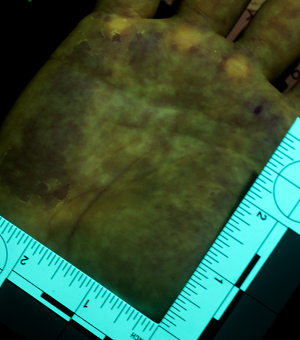
Details of a bruise on a victim, for instance, a bite mark or a shoe mark, can link a suspect to the victim. Furthermore, details of a bruise pattern in a suspects palm can link a suspect to a weapon.
 |  |
Bruise on neck; left visible light no camera filter, right 415nm illumination with Yellow camera filter. | |
First, individuals differ greatly in how they bruise. Some individuals will show bruising instantly or strongly, others might not show any evidence at all. Some may show no long term signs of bruising, some may show evidence, days, weeks, and even months later. Second with regard to multiple wavelengths, different colors penetrate to different depths within the skin and therefore depending on the depth of the bruise or wound you will need to vary the wavelength of the illumination. Deep wounds may require infrared illumination to get enough skin penetration.
 |  |
Bruise made by belt; left visible light no camera filter, right 415nm illumination with Yellow camera filter. | |
That would be through illuminating the skin with a particular wavelength of light and the detection of the darkening of the skin underneath the surface which is the result of blood vessel breakage and blood spillage underneath the skin.
 |  |
Palm of hand after benchpressing (wearing gloves); left in visible light, right 415nm illumination with Yellow camera filter. | |
The general rule of thumb for the detection of bruising is to start with illuminating the skin with blue wavelength and using clear goggles. If bruising has already occurred, the staining of the tissue by the blood spillage will appear darker or more visible than without the illumination.
After the use of the blue illumination, the examiner should try illuminating in the purple or violet. In most cases, the violet, purple, and blue illumination will show the darkening under the skin best.
As there is no good way to rule out that any individual may or may not bruise like any other, the best possible procedure would be to try every wavelength illumination available with every color goggle available; the more wavelengths the better.
Do you have any questions or requests? Use this form to contact our specialists.